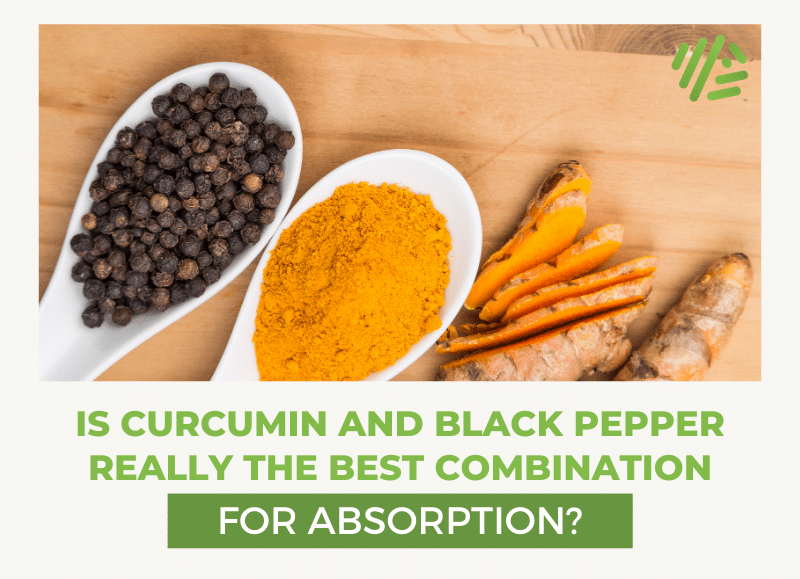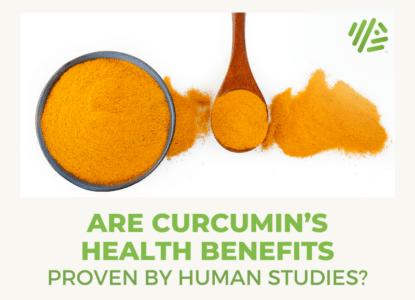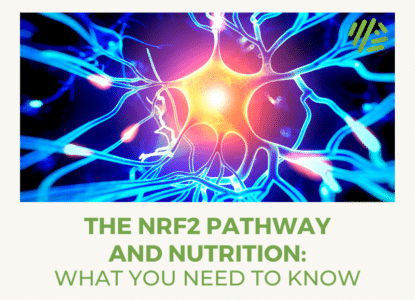Why Curcumin and Black Pepper is a Risky Combination For Some People

Curcumin, one of the antioxidants called found in turmeric, is all the rage in the supplement world. The problem is curcumin is poorly absorbed as a supplement, which leads many manufacturers to pair it with other compounds, such as black pepper, which increase bioavailability – i.e. how much curcumin ends up in your bloodstream.
As a physician, I have concerns about adding black pepper to curcumin supplements, which I will detail in this post.
Turmeric and black pepper
Curcumin is poorly absorbed and quickly metabolized, so supplement manufacturers are always looking for ways to increase absorption. In the U.S., bigger is seen as better. If a little turmeric is healthy for us, a mega-dose of turmeric’s primary antioxidant, curcumin must be even better, or so the thinking goes.
For a few years now, the conventional wisdom has been that black pepper and curcumin should be taken side by side, as black pepper has been shown to increase curcumin’s bioavailability by 2,000% over curcumin alone. 1
Pairing curcumin with black pepper will increase bioavailability, but black pepper has the potential to slow the metabolism of multiple drugs, potentially blunting the health benefits of curcumin by causing the unhealthy accumulation of OTC and pharmaceuticals in the body. 2 While the blogosphere loves to tout black pepper’s ability to increase the absorption of tumeric and curcumin, this pairing might not be a great idea for friends and family members who take prescription medication.
According to the Health Policy Institute at Georgetown University, more than 131 million Americans take prescription medication of some kind.
The good news is that black pepper isn’t the only compound that can help absorb more turmeric.
Curcumin is amphiphilic
Meaning it can dissolve into water or fat.
Just like carotenoids, curcumin is fat soluble, meaning it is better absorbed when paired with fat. For this reason, “curcumin phytosome” products, which dissolve curcumin in either phosphatidylcholine or lecithin, are all the rage right now, and some have data to back them up.
For example, this study examining Meriva, a curcumin phytosome product, and its impact on ostearthritis, seems to justify the practice of blending curcumin with phospholipids. Meriva uses a phosphatidylcholine blend produced from sunflower.
To quote the study:
These results show that Meriva® is clinically effective in the management and treatment of osteoarthritis and suggest that the increased stability and better absorption of curcumin induced by complexation with phospholipids have clinical relevance, setting the stage for larger and more prolonged studies.
The Meriva study seems to corroborate others that have looked at ways of enhancing curcumin’s bioavailability. For his post evaluating curcumin’s health benefits, Aaron put together this chart which shows the various methods developed for adding curcumin to a phospholipid blend, as well as dissolving it in a water based solution:
| Curcuminoid | CS | CTR | CP | CHC |
|---|---|---|---|---|
| Curcumin | 1.0 | 2.6 | 12.7 | 136.3 |
| Demethoxycurcumin | 1.0 | 0.6 | 7.3 | 14.2 |
| Bisdemethoxycurcumin | 1.0 | 1.3 | 3.5 | 5.3 |
| Tetrahydrocurcumin | 1.0 | 1.3 | 8.3 | 33.5 |
| Total Curcuminoids | 1.0 | 1.3 | 7.9 | 45.9 |
CS = standardized curcumin mixture, CTR = curcumin with volatile oils to aid absorption, CP = curcumin with lipophilic phytosomes (lipid loving molecules to aid absorption), CHC = curcumin with PVP and natural antioxidants. Values are relative absorption of various curcuminoids into the blood, actual values are available in the paper. Red colored values are the worst performing for each type of curcuminoid, greens the best.
As you can clearly see in the table above, the CHC preparation (which features Polyvinylpyrrolidone (PVP) and vitamin C and E) significantly outperforms all other preparations, especially pure curcumin alone. So, while phospholipids elevate the bioavailability of curcumin, the water soluble formula plus antioxidants outperforms them all. Now, keep in kind that both the Meriva and PVP studies appear to have been conducted by interested parties, but I see the willingness to engage in actual clinical trials encouraging, and will take the absorption data at face value.
Bottom line is this is what we have to go on at the moment.
The bioavailability data cited above demonstrates that curcumin is amphiphilic, meaning it loves fat and it loves water.
Curcumin phospholipid products
As consumers of supplements, we all hold our noses and swallow a litany of “other ingredients,” such as magensium stearate or soy lecithin, because they are included in very tiny amounts to facilitate delivery of nutrients we believe are good for us.
However, what happens when those ingredients become part of the main dish? In the world of curcumin supplementation, phospholipids are becoming a bigger part of the pie.
Some brands, like Gaia for example, are dissolving curcumin in phospholipid solutions that contain unknown amounts of soy lecithin. Others, like the Seeking Health Liposomal Curcumin product add curcumin to phosphatidylcholine in a similar fashion to Meriva.
Does the addition of these fats alter the health benefits of curcumin? Likely not in a significant way, but I would prefer top avoid the omega-6 fats the liposomal products are dissolved in.
Phosphatidylcholine and trimethylamine-N-oxide (TMAO)
TMAO is a metabolite of phosphatidylcholine and lecithin that has been linked to an increased risk of heart disease. How? Our gut bacteria break down these phospholipid fats into a substance (TMAO) that is thought to damage our arteries. I generally stay away from lecithin and liposomal supplements because of this TMAO data.
A New England Journal of Medicine study found that increased levels of TMAO were a significant independent risk factor for heart disease, even for people with otherwise normal markers.
To quote the NEJM study:
After adjustment for traditional risk factors and other baseline covariates, elevated plasma levels of TMAO remained a significant predictor of the risk of major adverse cardiovascular events.
The NEJM study calls out phosphatidylcholine directly as a causative agent in producing TMAO:
We recently described the potential role of a complex phosphatidylcholine–choline metabolic pathway involving gut microbiota in contributing to the pathogenesis of atherosclerotic coronary artery disease in animal models. We also reported an association between a history of cardiovascular disease and elevated fasting plasma levels of trimethylamine-N-oxide (TMAO), an intestinal microbiota-dependent metabolite of the choline head group of phosphatidylcholine that is excreted in the urine.
Some dismiss the NEJM study saying that eating fish, long thought to be heart protective, causes a spike in TMAO as well. As a result, they reason that we needn’t worry about TMAO. The NEJM study seems very sound to me. Its conclusions are reasonable and do not recommend avoiding phosphatidylcholine altogether.
It should also be noted that choline is a semi-essential nutrient and should not be completely eliminated from the diet, since this can result in a deficiency state. However, standard dietary recommendations, if adopted, will limit the intake of phosphatidylcholine- and choline-rich foods, since these foods are also typically high in fat and cholesterol content.
Limit phosphatidylcholine to keep TMAO levels in check, got it.
From where I’m sitting, I want to use my choline intake on foods I enjoy, like the occasional steak, or fried egg, not on sunflower oil goo unnecessarily added to a supplement.
TMAO can be excreted in urine rendering it harmless. It is only when levels build that problems can arise. What better way to build TMAO levels than to take phosphatidylcholine on a daily basis in the form of a supplement? And the sad part is that most people have no clue what they are taking. We are trained to ignore the peripheral “other ingredients” on our supplement labels.
Ask someone taking Mariva what they are taking and they will answer curcumin, but they are also taking a daily dose of phosphatidylcholine. Daily ingestion of curcumin product like this could contribute to bad outcomes over time for some people.
Furthermore, TMAO isn’t the only issue with choline and lecithin supplements. Many of these fats can raise the body’s omega 6 levels, which is also inflammatory.
The irony for me is that some of the data points to an increase in bioavailability with water soluble, antioxidant solutions that exclude potentially unhealthy fats.
If phospholipids aren’t necessary for proper absorption of curcumin, why use them?
Summary
Although black pepper can increase the bioavailability of curcumin, which is a notoriously difficult supplement to get into the blood stream, research shows that antioxidants can work even better, and without the side effects some may experience when taking piperine with prescription medications.




If I put my curcumin capsule in hot tea or coffee with al.ond milk, for the fat, is that a good way to get better a absorbtion
my Cardiologist wants me to take 500 mg with bioperine for absorption 2 times a day for imflamation. The black pepper bothered my acid reflux. Will the Nordic Naurals with omega be comparable in bioavailability?
I cannot find the 2 top products that you mentioned in the UK.
to try to replicate the omega curcurin by Nordic naturals, can I just take curcumin with omega-3 and get the same result?
Can you evaluate a product called CURCUMIN from a brand called Smarter Nutrition?
Thanks.
I put curcin 95% curcumoids into my husband’s smoothie. The smoothie is made with banana, strawberries, blueberries, whey protein powder and 1 TBSP. of Chia seeds. He’s had great results with inflammation with this combo. Do you see any issues with this combination? If so, I will stop the Curcumin.
Not only are there not really any solid clinical trials demonstrating additional benefits of adding black pepper extract to Curcumin, it is potentially dangerous. Through multiple mechanisms, it can effect metabolism of a long list of both OTC and pharmaceuticals. Unintentionally slowing drug metabolism can lead to dangerous residual levels of these drugs in circulation.
There is also the “we don’t know” factor many companies don’t take into account when dealing with different raw materials like Turmeric. While the race is on to increase levels of serum curcuminoids and put out attractive marketing ploys, no one is considering the potential loss of long-term efficacy when you alter the way these things interact with the microbiome. Some of the recent data on Berberine attributes at least part of its glycemic regulating properties to its modulation of the gut microbiome. This could be lost by changing solubility and its natural absorption pathways.
It’ll be interesting to see where the “bioavailability” conversation goes. Marketing is so far ahead of the science in this industry and this conversation, to this point is driven more by sexy marketing campaigns, attempting to differentiate products more than anything else, at least as far as any clinical relevancy.